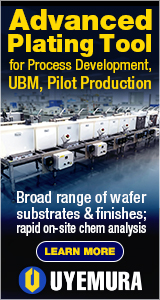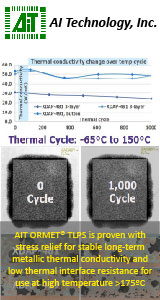|

|
|
| Ask the Experts | |||||||
|
|||||||
|
August 3, 2017 - Updated July 4, 2007 - Originally Posted Baking lead-free and lead PCB's before assemblyDo we need to bake every rigid-flex board before assembly? What are the conditions of baking process? Is it the same as for the rigid one? Are there differences in baking between Lead Free boards and Pb boards? Anna Seredovaya |
|||||||
| Expert Panel Responses | |||||||
|
They should be on trays. Make sure the trays are low outgassing and can survive the temperature of the baking process. Why are you baking PCBs in the first place?
CEO & Managing Partner DfR Solutions Dr. Hillman's specialties include best practices in Design for Reliability, strategies for transitioning to Pb-free, supplier qualification, passive component technology and printed board failure mechanisms.
You haven't given the reason for the required baking process, so I'll give you the "Lessons Learned" from our three-year "Proof-of Process Experiments" that developed a low-temperature drying process for moisture-sensitive devices in tape. In it we worked with 125C material baking as well. 1. I assume that you will be baking at the common temperature of 125C. This is a common bake-out temperature. 2. Our findings showed that materials in solid packs and those that are individually separated show identical process results. Keep in mind that there is a lag-time to the point where the interior of the packs reach process temperature. We found this to be a short period of time. 3. Caution: Baking will deteriorate the solderability of the runs through generation of Intermetallics and plating surface degeneration. There can be a loss of surface wettability due to baking. Lead-free solders have wetting problems right out of the box, so don't magnify the problem by excessive baking. This is the reason that IPC/JEDEC J-Std-033B limits the maximum hours of 125C baking to 48-hours. Feel free to contact me with any additional questions.
Director of Engineering Innovative Drying Co. Mr. Leech lead a successful 2 year long process development effort that identified the parameters required to rapidly dry moisture sensitive devices while they were encased in the tape and reel format. Mr. Leech has over thirty years of experience as a manufacturing engineering manager in the electronics industry.
NOTE: Mr. Leech is no longer working at Innovative Drying Co. I'm not sure that I can give a comprehensive answer, but I will attempt to give you some helpful information. One of the reasons to bake PCBs is to remove the moisture. I am most familiar with the underfill process on PCB, either flip chip on board or underfill of BGA. In these cases, moisture on the board can cause voiding and de-lamination during cure. From surface mount components, it is also possible to get "pop corning" of components that are attached with surface mount adhesive. If you stack the boards touching each other, it is likely that you will have to increase the baking time to remove the moisture. Separation of the boards will reduce the needed baking time for moisture removal. I am unaware of any difference the direction of stacking makes. Baking boards at temperatures above 100C (the boiling point of water) will guarantee that all the moisture will be eventually removed. Higher temperatures will speed up the process. The amount of pre-bake required depends on the thickness of the board, the amount of latent moisture, and the acceptable level of moisture for the manufacturing process. If you suspect that you are having moisture in your process, a good way to monitor the moisture level is weight. We often recommend that our customers weigh a small board (or a sample coupon of the same thickness) on a precision balance, pre-bake for two hours at 100 C, allow it to cool, then re-weigh the parts you should be able to note a weight difference. You can use this weight difference to compare other pre-bake temperatures and times. Obviously, thinner boards will require less time. Depending on your ambient environment, the boards will re-absorb moisture. You can weigh the sample coupon on regular periods after pre-bake to chart the rate of moisture absorption. Another method of improving the moisture removal process is to use vacuum. Baking the parts at a reduced pressure will speed up the moisture removal, however, I'm not sure this is a production friendly process.
Director of Application Engineering Asymtek Mr. Lewis worked for The Aerospace Corporation for 6 years before joining Asymtek in 1993. He holds multiple patents in dispensing technology for electronics assembly and packaging. He has a Master's Degree in Mechanical Engineering from University of Missouri-Rolla.
NOTE: Mr. Lewis is no longer working at Asymtek. With respect to baking boards or substrates, typically the reason to do this is to remove absorbed moisture from the substrate so that there are no issues with moisture or water outgassing during subsequent processes. Therefore first of all you should be above the boiling temp of water, 100C. Also, you need to allow enough time for any of the moisture adsorbed in the inner layers to make their way out of the PCB. Depending on the board thickness this can be 4+ hours. Since you want the moisture (and other solvents, possibly) to escape, the best way to do this is to have the boards in a rack, vertically with some space in between the PCBs. If they are stacked on top of one another or flat on the base of the oven, etc. then it is can be more difficult for the moisture to escape. The other thing to keep in mind is that heating the PCBs will increase the rate of oxidation. Since oxidation on the PCB pads will impact the soldering performance you don't want to keep re-baking boards over and over again if you are going to try to solder them in a subsequent process.
Application Engineering Henkel Electronics Dr. Brian Toleno is the Application Engineering Team leader for Henkel Technologies. He is responsible for the technical service and application engineering for Henkel's electronics assembly materials, including solder paste, underfills, PCB protection materials, and underfills.
Why do you have to bake PCBs? Also what is the finish? Depending on the reason you more than likely need to space the boards. However your surface finish may deteriorate during baking and cause more soldering issues. If it is to remove moisture you need to bake at 105 C until the mass of boards reaches this temperature and hold it for a set cycle depending on how much moisture needs to be removed. If you are baking due to a curing issue you will have to back at a higher temperature. It depends on why you need to bake.
Deck Street Consultants In his 32 years of industry experience, Mr. Seelig has authored over 30 published articles on topics including lead-free assembly, no-clean technology, and process optimization. Karl holds numerous patents, including four for lead-free solder alloys, and was a key developer of no-clean technology.
|
|||||||
| Submit A Comment | |||||||
|
Comments are reviewed prior to posting. You must include your full name to have your comments posted. We will not post your email address. |
|
Free Newsletter Subscription
Circuitnet is built for professionals who bear the responsibility of looking ahead, imagining the future, and preparing for it. Insert Your Email Address |
|

|






